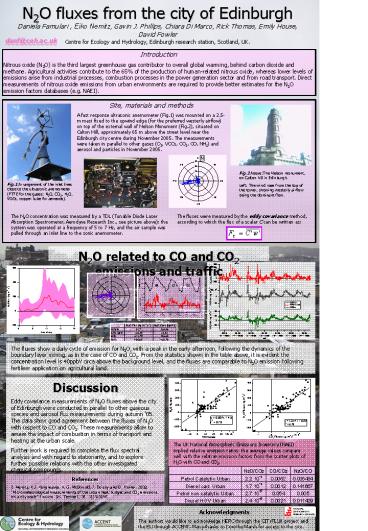Acknowledgments - PowerPoint PPT Presentation
1 / 1
Title:
Acknowledgments
Description:
... picture above): the system was operated at a frequency of 5 to 7 Hz, and the air ... The fluxes show a daily cycle of emission for N2O, with a peak in the early ... – PowerPoint PPT presentation
Number of Views:81
Avg rating:3.0/5.0
Title: Acknowledgments
1
N2O fluxes from the city of Edinburgh Daniela
Famulari , Eiko Nemitz, Gavin J. Phillips, Chiara
Di Marco, Rick Thomas, Emily House, David
Fowler Centre for Ecology and Hydrology,
Edinburgh research station, Scotland, UK.
danf_at_ceh.ac.uk
Introduction Nitrous oxide (N2O) is the third
largest greenhouse gas contributor to overall
global warming, behind carbon dioxide and
methane. Agricultural activities contribute to
the 65 of the production of human-related
nitrous oxide, whereas lower levels of emissions
arise from industrial processes, combustion
processes in the power generation sector and from
road transport. Direct measurements of nitrous
oxide emissions from urban environments are
required to provide better estimates for the N2O
emission factors databases (e.g. NAEI).
Site, materials and methods A fast response
ultrasonic anemometer (Fig.1) was mounted on a
2.5-m mast fixed to the upwind edge (for the
preferred westerly airflow) on top of the
external wall of Nelson Monument (Fig.2),
situated on Calton Hill, approximately 65 m above
the street level near the Edinburgh city centre
during November 2005. The measurements were taken
in parallel to other gases (O3, VOCs, CO2, CO,
NH3) and aerosol and particles in November 2005.
Fig.2 AboveThe Nelson monument, on Calton hill
in Edinburgh. Left The wind rose from the top
of the tower, showing westerly airflow being the
dominant flow.
Fig.1 Arrangement of the inlet lines close to the
ultrasonic anemometer (PTFE for the gases N2O,
CO2, H2O, VOCs, copper tube for aerosols).
The fluxes were measured by the eddy covariance
method, according to which the flux of a scalar C
can be written as
The N2O concentration was measured by a TDL
(Tunable Diode Laser Absorption Spectrometer,
Aerodyne Research Inc., see picture above) the
system was operated at a frequency of 5 to 7 Hz,
and the air sample was pulled through an inlet
line to the sonic anemometer.
N2O related to CO and CO2 emissions and traffic
The fluxes show a daily cycle of emission for
N2O, with a peak in the early afternoon,
following the dynamics of the boundary layer
mixing, as in the case of CO and CO2. From the
statistics shown in the table above, it is
evident the concentration level is 40ppbV circa
above the background level, and the fluxes are
comparable to N2O emission following fertiliser
application on agricultural land.
Discussion Eddy covariance measurements of N2O
fluxes above the city of Edinburgh were conducted
in parallel to other gaseous species and aerosol
flux measurements during autumn 05. The data
show good agreement between the fluxes of N2O
with respect to CO and CO2. These measurements
allow to assess the impact of combustion in terms
of transport and heating at the urban
scale. Further work is required to complete the
flux spectral analysis and with regard to
stationarity, and to explore further possible
relations with the other investigated chemical
compounds.
The UK National Atmospheric Emissions Inventory
(NAEI) implied relative emission ratios the
average values compare well with the relative
emission factors from the scatter plots of N2O
with CO and CO2.
References E. Nemitz, K.J. Hargreaves, A. G.
McDonald, J. Dorsey and D. Fowler, 2002,
Micrometeorological measurements of the urban
heat budget and CO2 emissions on a city scale
Environ. Sci. Technol., 36, 3139-3146.
Acknowledgments The authors would like to
acknowledge NERC through the CITYFLUX project and
the EU through ACCENT. Many thanks to Dorothy
Marsh for access to the site.































